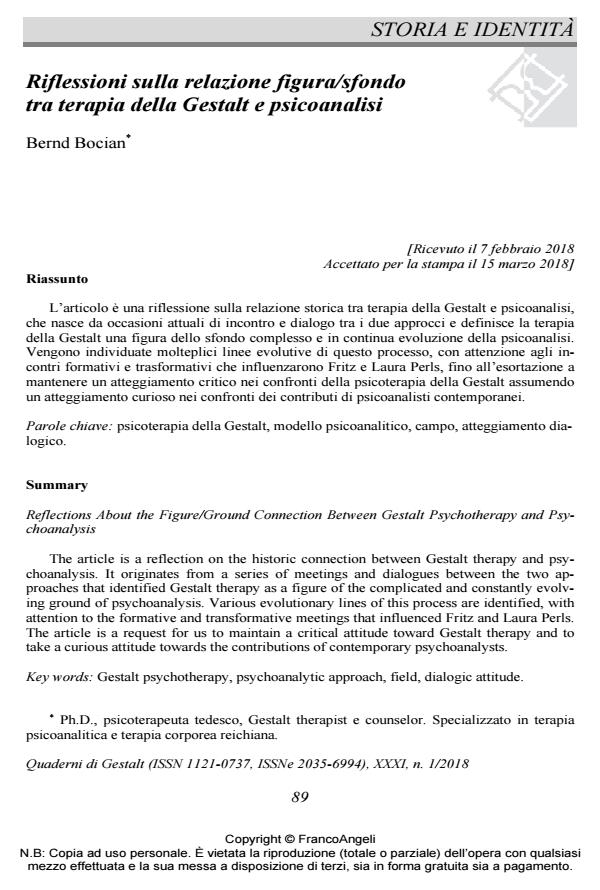Reflections About the Figure/Ground Connection Between Gestalt Psychotherapy and Psychoanalysis
Journal title QUADERNI DI GESTALT
Author/s Bernd Bocian
Publishing Year 2018 Issue 2018/1
Language Italian Pages 13 P. 89-101 File size 197 KB
DOI 10.3280/GEST2018-001007
DOI is like a bar code for intellectual property: to have more infomation
click here
Below, you can see the article first page
If you want to buy this article in PDF format, you can do it, following the instructions to buy download credits

FrancoAngeli is member of Publishers International Linking Association, Inc (PILA), a not-for-profit association which run the CrossRef service enabling links to and from online scholarly content.
The article is a reflection on the historic connection between Gestalt therapy and psychoanalysis. It originates from a series of meetings and dialogues between the two approaches that identified Gestalt therapy as a figure of the complicated and constantly evolving ground of psychoanalysis. Various evolutionary lines of this process are identified, with attention to the formative and transformative meetings that influenced Fritz and Laura Perls. The article is a request for us to maintain a critical attitude toward Gestalt therapy and to take a curious attitude towards the contributions of contemporary psychoanalysts.
Keywords: Gestalt psychotherapy, psychoanalytic approach, field, dialogic attitude
- Aron L. (2004). Menti che si incontrano. Milano: Raffaello Cortina (ed. or.: A Meeting of Minds: Mutuality in Psychoanalisys. New York: The Analytic Press, 1996).
- Atwood G.E., Stolorow R.D. (2001). Volti nelle nuvole. Intersoggettività nella teoria della personalità. Roma: Borla (ed. or.: Faces in a Cloud: Intersubjectivity in Personality Theory. Northvale, NJ: Jason Aronson, 1979).
- Benjamin J. (2006). L’ombra dell’altro. Intersoggettività e genere in psicoanalisi. Torino: Bollati Boringhieri (ed. or.: Shadow of the Other: Intersubjectivity and Gender in Psychoanalysis. London, UK: Psychology Press, 1998).
- Bocian B. (2012). Fritz Perls a Berlino 1893-1933: Espressionismo, psicoanalisi, ebraismo. Milano: FrancoAngeli (ed. or.: Fritz Perls in Berlin 1893 - 1933: Expressionism, Psychoanalysis, Judaism. Berlin, Bergisch Gladbach: EHP – Verlag Andreas Kohlhage, 2010).
- Bocian B. (2012). Freud, Goodman e le scissioni. Quaderni di Gestalt, XXV, 1: 121-138. DOI: 10.3280/GEST2012-001012
- Bromberg P.M. (2012). L’ombra dello Tsunami. La crescita della mente relazionale. Milano: Raffaello Cortina Editore (ed. or.: The Shadow of the Tsunami: And the Growth of the Relational Mind. New York, NY: Routledge, 2011).
- Clements C.C. (1969). Acting Out versus Acting Through: An Interview with Frederick Perls. Voices, 4, 4: 66-73.
- Cremerius J. (1992). Die Psychoanalyse gehört niemandem. Als Wissenschaft vom Menschen darf sie nicht monopolisiert werden. In: Wiesse J., a cura di, Chaos und Regel. Die Psychoanalyse in ihren Institutionen. Göttingen: Vandenhoek & Ruprecht, 34-50.
- Eagle M.N. (2012). Da Freud alla psicoanalisi contemporanea. Critica e integrazione. Milano: Raffaello Cortina (ed. or.: From Classical to Contemporary Psychoanalysis: A Critique and Integration. New York, NY: Routledge, 2011).
- Ehrenberg D.B. (2009). I limiti dell’intimità. Potenziare l’interazione psicoanalitica. Milano: Centro Scientifico Editore (ed. or.: The Intimate Edge: Extending the Reach of Psychoanalytic Interaction. New York, NY: W.W. Norton and Co., 1992).
- Ferenczi S., Rank O. (2017). Traiettorie di sviluppo della psicoanalisi. Sull’interazione tra teoria e pratica. Lecce: Youcanprint (ed. or.: The Development of Psychoanalysis. New York & Washington: Nerv. Mental, Dis. Publ., 1925).
- Feuerbach L. (1978). Contro il dualismo di corpo e anima, carne e spirito. In: Pacchi A.,a cura di,. Materialisti dell’Ottocento. Bologna: Il Mulino.
- Lewis A. (2004). Menti che si incontrano. Milano: Raffaello Cortina Editore (ed. or.: A Meeting of Minds: Mutuality in Psychoanalisys. New York, NY: The Analytic Press, 1996).
- Lichtenberg P. (2009). La psicoterapia della Gestalt come rinnovamento della Psicoanalisi Radicale. Quaderni di Gestalt, XII, 2: 45-68. DOI: 10.3280/GEST2009-002004
- Lorenzer A. (1993). Intimität und soziales Leid. Archäologie der Psychoanalyse. Frankfurt: Fischer Wissenschaft.
- Migone P. (2011). Prefazione. In: Spagnuolo Lobb M., Il now-for-next in psicoterapia. La psicoterapia della Gestalt raccontata nella società post-moderna. Milano: Franco Angeli, 15-18.
- Mitchell S.A., Black M. (1996). L’esperienza della psicoanalisi. Storia del pensiero psicoanalitico moderno. Torino: Bollati Boringhieri (ed. or.: Freud and Beyond. A History of Modern Psychoanalytic Thought. New York, NY: Basic Books, 1995).
- Orange D.M. (2001). La Comprensione Emotiva. Roma: Astrolabio (ed. or.: Emotional Understanding: Studies in Psychoanalytic Epistemology. New York: Guilford, 1995).
- Orange D.M., Atwood G.E., Stolorow R.D. (1999). Intersoggettività e lavoro clinico. Il contestualismo nella pratica psicoanalitica. Milano: Raffaello Cortina Editore (ed. or.: Working Intersubjectively: Contextualism in Psychoanalytic Practice. Hillsdale, NJ: The Analytic Press, 1997).
- Panizza S. (2008). La prospettiva relazionale in psicoanalisi. Storia, teoria e clinica. Milano: FrancoAngeli.
- Perls F.S. (1980). La terapia gestaltica parola per parola, Milano: Astrolabio (ed. or.: Gestalt Therapy Verbatim. Moab, UT: Real People Press, 1969).
- Perls F.S. (2016). La psicoterapia pianificata (White Institute New York, 1947). Quaderni di Gestalt, XXIX, 2: 99-118. DOI: 10.3280/GEST2016-002009
- Perls F.S., Hefferline R.F., Goodman P. (1997). Teoria e pratica della terapia della Gestalt: Vitalità e accrescimento nella personalità umana. Roma: Astrolabio (ed. or.: Gestalt Therapy: Excitement and Growth in the Human Personality. New York: The Gestalt Journal Press, 1951; 1995).
- Perls F.S. (2012). From Planned Psychotherapy to Gestalt Therapy: Essays and Lectures (1945-1965) of Frederick Salomon Perls, M.D. Gouldsboro, ME: Gestalt Journal Press.
- Reich W. (1996). Jenseits der Psychologie. Briefe und Tagebücher 1934-1939. Köln: Kiepenheur & Witsch.
- Safran J.D. (2013). Psicoanalisi e terapie psicodinamiche. Milano: Raffaello Cortina Editore (ed. or. Psychoanalysis and Psychoanalytic Therapies. Washington, DC: American Psychological Association, 2011).
- Stern D.B. (2017). Libertà relazionale. Caratteristiche del campo interpersonale. Milano: Mimesis (ed. or.: Relational Freedom: Emergent Properties of the Interpersonal Field, New York, NY: Routledge, 2015).
- Waldvogel B. (1992). Psychoanalyse und Gestaltpsychologie. Historische und theoretische Berührungspunkte, Stuttgart-Bad Cannstatt: Frommann-Holzboog
Bernd Bocian, Riflessioni sulla relazione figura/sfondo tra terapia della Gestalt e psicoanalisi in "QUADERNI DI GESTALT" 1/2018, pp 89-101, DOI: 10.3280/GEST2018-001007